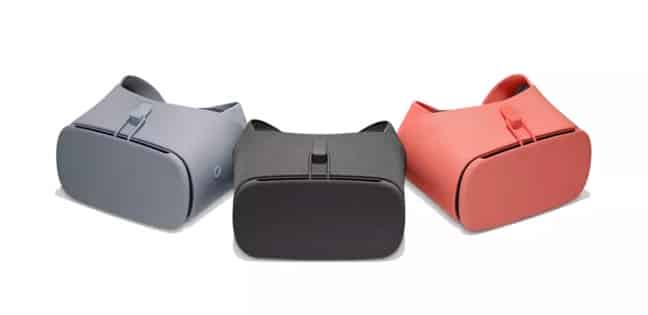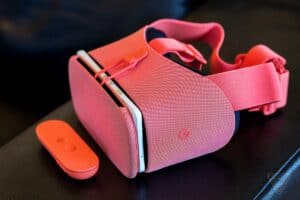The new Google VR headset appeared today along with new Pixel phones and Google Home devices. Google’s Daydream View headset arrived in November 2016. While not matching the Samsung’s Gear VR’s popularity, it’s staked out a small but steady share of the VR headset market.
You won’t find any jaw-dropping improvements in the new version, but it’s a step up from the current model. According to Adi Robinson in The Verge,
The new View uses custom-designed wider lenses and has a field of view that’s supposedly 10 to 15 degrees wider than before. (People’s experience will vary based on their phone’s screen size.) Its face mask has been redesigned to spread pressure more evenly, and a removable top strap makes it feel more secure. The remote now clips to the main strap, instead of fitting inside the front panel, since [VR product manager Andrew] Nartker says that people wanted to be able to access it more quickly. And the new front panel doubles as a heat sink, with a hollow design that’s supposed to cool the phone more than just leaving it uncovered.
While we’ve yet to try it, the removable top strap should add to the comfort level. You’re holding your Smartphone on your face – distributing the weight can only help for extended VR experiences. And a better face mask is welcome, especially if it takes care of the light bleed around the nose area.
There are no reviews of the lenses yet, though a wider field of view (FOV) is promised. That will be popular given the huge interest in increasing the FOV. See the recent success of the Pimax VR headset (though it won’t come close to the latter’s claimed 200° FOV).
The future of the new Google VR headset

Part of the challenge for Daydream View is the lack of compatible phones. When it first arrived, you had few choices outside of a Pixel phone. It now works with 12 phones including Samsung’s popular Galaxy S8, S8 Plus, and Note 8 models. But it doesn’t come close to Google Cardboard which supports iOS. The Daydream Android app reached 1 million installs this summer, but that’s nowhere near the over 25 million Cardboard app downloads. And according to Clay Bavor, who leads Google’s virtual and augmented reality projects, iOS support is “. . . not in the cards at all for now.”
That raises a question over Google’s VR projects and what’s missing in today’s release. Google is working on a stand-alone headset – which is almost essential. With Microsoft’s new Mixed Reality headsets already available on pre-order and Samsung’s dominant position in the mobile VR space, Daydream View will get squeezed from both sides.
We expect to see Google release a self-contained headset with positional tracking at the Spring 2018 I/O conference. And it will cost considerably more than Daydream, probably around $400.
There’s a lot to like about the new Google VR headset – the fabric construction, the hand-controller, wider FOV, and the simple insert-phone-and-play design. In virtual reality time, it’s an old friend. But it occupies a limited market niche – a step above Google Cardboard but unable to dethrone Gear VR or deliver a stand-alone HMD experience.
With so many developments in VR, its future is very much up in the air.
Emory Craig is a writer, speaker, and consultant specializing in virtual reality (VR) and artificial intelligence (AI) with a rich background in art, new media, and higher education. A sought-after speaker at international conferences, he shares his unique insights on innovation and collaborates with universities, nonprofits, businesses, and international organizations to develop transformative initiatives in XR, AI, and digital ethics. Passionate about harnessing the potential of cutting-edge technologies, he explores the ethical ramifications of blending the real with the virtual, sparking meaningful conversations about the future of human experience in an increasingly interconnected world.

